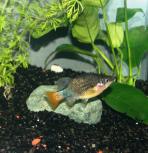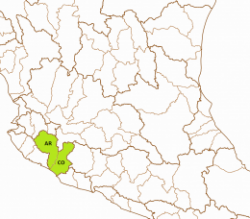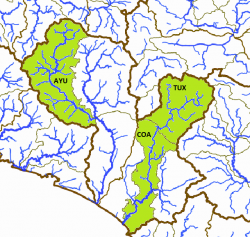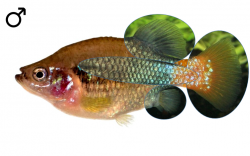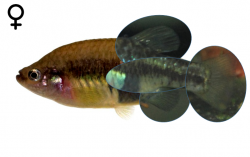- HOME
- WHO WE ARE
- NEWS AND DATES
- GOODEIDS
- PHYLOGENY
- ARTIFICIAL KEY
- GOODEID SPECIES
- BIOLOGY
- ENVIRONMENT
- CONSERVATION
- PROFUNDULIDS
- MEMBERS AREA
"Xenotoca" lyonsi
English Name:
Tamazula Redtail Splitfin
Mexican Name:
Mexclapique (erronously: Mexcalpique) de Tamazula
Original Description:
Holotype:
Collection-number: Colección de Peces de la Universidad de Michoacán, Cat. No. CPUM-9590, CPUM-T-41522.
The Holotype is an adult male 55 mm standard length, collected on July the 12th, 2015. Together with the Holotpye were collected 30 Paratypes of both sexes and deposited in several institutes (Cat. No.'s CPUM-5542, CPUM-T-5217, 5221–5223, 5226, 5228, 5230–5232, 5234, 5236–5241, 5244–5245, 5249; MNCN_ICTIO 290.848-290.851;CPUM-T- 12036–12038; CNPE-IBUNAM20840). Three more specimens (Cat. No.'s CPUM-5541, CPUM-T-12038–12040) collected on June the 20th, 2010, in the Tamazula River at Santa Cruz del Cortijo in Vista Hermosa Village, were added to the description.
The left photos show the Holotype and a female Paratype of "Xenotoca" lyonsi, the right one a pair of "speckled eiseni", Photo by E. Schraml (see also the chapter "Remarks"):
Terra typica:
The type location is the Río Tamazula, Coahuayana drainage, just five km Northeast of the town of Tamazula de Giordano, federal state of Jalisco.
Etymology:
The species is named for "the prominent North American ichthyologist, Dr. John Lyons, who has made substantial contributions to our understanding of the distribution, ecology, diversity, and conservation status of fishes in Mexico, and to Goodeids in particular."
This species belongs to an undescribed genus, but until the changement has happened, it stays integrated in Xenotoca. The genus Xenotoca was erected for Characodon variatus by Hubbs and Turner in Turner, 1937, because "this species differs from Characodon (lateralis) in numerous internal as well as external features. Characters distinguishing Xenotoca from Characodon involve the ovarian anatomy, the form and structure of the trophotaeniae, and some superficial features". The generic name can be derived from the ancient Greek with the word ξένος (xénos) meaning strange and and τόκος (tókos) offspring. Xenotoca can therefore be translated with "a strange type of offspring".
Synonyms:
Characodon eiseni Rutter, 1896
Characodon variatus Regan, 1907
Xenotoca eiseni Fitzsimons, 1972 (partially)
Distribution and ESU's:
The Tamazula Redtail Splitfin is endemic to the Mexican federal state of Jalisco. It was historically known from the Río Tuxpan drainage including the Río Tamazula and several affluents (e.g. Río San Gregorio), from the Río El Terrero, an affluent of the middle section of the Río Coahuayana named Río Naranjo and from a section of the Río Ayuquila, Río Armería drainage. The affiliation of the last subpopulation to "Xenotoca" lyonsi needs to be verified, but is very likely (Lyons, 2018, pers. comm.). It has not been found within in the last decades in the Río El Terrero and became very scarce in habitats along the Río Tamazula. The stock in the Río Ayuquila has not been found since the 1990's and is regarded possibly Extinct. The type locality is in a highly seasonally changed Tamazula River, approximately 5 km northeast of the town of Tamazula town. The new species also has been reported in other locations along the Tuxpán and Tamazula rivers near Ferreria, Soyatlan de Afuera, San Rafael, Tuxpán and Atenquique villages, but most of these localities no longer harbour "Xenotoca" lyonsi and it is presumed to be locally extirpated. As the species occurs in three separate drainages, three subpopulations, the Río Tuxpán subpopulation (type subpopulation), the Río El Terrero subpopulation and the Río Armería subpopulation can be distinguished. The bold names are the ones officially used by the Instituto Nacional de Estadística y Geografía; nevertheless, other ones might be more often in use or better known and therefore prefered.
ESU ist short for Evolutionarily Significant Unit. Each unit expresses an isolated population with different genetic characteristics within one species. ESU's can be defined by Molecular genetics, Morphology and/or Zoogeography and help in indicating different phylogenetic lineages within a species. The abbreviation for an ESU is composed of three letters of the genus, followed by the first two letters of the species name and an ongoing number in each species.
In "Xenotoca" lyonsi, we can probably distinguish two different ESU's: The Río Tamazula populations belong to Xenly1 (before: Xenei3), and as we consider here the population of "Xenotoca" eiseni type fish from the Ayuqila river as "Xenotoca" lyonsi (or a closely related species), we give it the ESU Xenly2 (sensu Lyons: Xenei4).
The left map shows the ríos Coahuayana (CO) and Armería (AR) basins from the Hydrographic Region Armería-Coahuayana on a Mexico map. The Tamazula Redtail Splitfin is known from the Río Coahuayana subbasin (COA), where it occured in the northern borderlands, but seems to be extinct nowadays, and from the Río Tuxpan (TUX) subbasin, where the species is rare. Both subbasins of the Río Coahuayana basin are home to the ESU Xenly1. The "Xenotoca" from the Río Ayuquila subbasin (AYU) are regarded by John Lyons as "Xenotoca" lyonsi, too, and it seems likely due to distribution patterns of other fish species from this region, so they are considered on the right map here. The ESU in use for them is Xenly2 (sensu Lyons: Xenei4); they seem to be extinct:
Status :
International Union for Conservation of Nature (IUCN): Critically Endangered
Distribution and current conservation status of the Mexican Goodeidae (Lyons et al., 2019): Endangered/declining: „This species was recently separated from X. eiseni (Domínguez-Domínguez et al., 2016). It is known from the upper Coahuayana River basin and is endangered. Historically it was widespread, but lack of water and water pollution have eliminated most populations.“
NOM-059-SEMARNAT-2010: no categoría de riesgo (no category of risk)
Habitat:
The type locality for "Xenotoca" lyonsi is an area with high seasonal changes in water clarity and volume, from a turbid and deep high flow running water in the rainy season to clear and low flow water other times of the year, sometimes reduced to a few shallow pools in the dry season. The bottom primarily is composed of mud and gravel, and water plants are only evident in the stream bed, which seems to change in composition and coverage depending on the season. The area is totally surrounded by sugar cane plantations. Other fish species collected in the area were "Xenotoca" melanosoma (now extirpated), Ilyodon whitei (Meek, 1904), Poecilia butleri (Jordan, 1889), Allodontichthys tamazulae (Turner, 1946), Allodontichthys hubbsi (Miller & Uyeno, 1980) and Astyanax anaeus (Günther, 1860), as well as the introduced Cyprinus carpio and Oreochromis sp. On a survey of the GWG in March 2016, this species was found at the type location in low numbers. Two more females were found in the Río Contla in November 2018. A survey of the GWG to the Río San Jeronimo drainage in March 2019 revealed a good stock in a spring on a private property in El Cortijo W of Vista Hermosa.
Biology:
Not much is known about its biology in nature. The reproductive period seems to be similar to the one of the closely related "Xenotoca" eiseni with fry in late spring or longer. On a survey of the GWG in February 2016, the group was able to find "Xenotoca" lyonsi east of the city of Tamazula de Giordano. The fish were inhabiting quiet parts of the clear and fast flowing Río Tamazula, but in low numbers. On another survey in November 2018, the members of the GWG found two females in the Río Contla, where this species was not present in 2016.
Diet:
From its cooccurence with "Xenotoca" melanosoma, which is mainly carnivorous, a more omnivorous feeding habit with plant material forming the greater volume of food, similar to the related species"Xenotoca" eiseni, can be inferred. The species seems to replace the Retail Splitfin in the southern part of the ancient Verde-Coahuayana paleoriver area.
Size:
The maximum standard length is 50mm (Domínguez-Domínguez et al., 2016)
Colouration:
When alive, the colouration varies with respect to the age and sex of the organism. Mature females show a general brownish colouration with a dark pigmented strip along the body, from the opercle to the hypural plate region that varies in intensity and width. Dark blotches are not evident in big females, but being more evident in the posterior half of the body when present. Scales are frequently rounded in their exterior margin by small black spots. A black blotch is present in the posteroventral region, between the pelvic and anal fins, which varied in depth and width. Juveniles have the same colouration than females, but as they reach ±20 mm they start to differentiate to adult colouration. Juveniles show a brownish translucent colouration with small darkblotches along the body. The fins are clear and unpigmented. Males show a colouration that varies depending on the size and reproductive stage, but in general the posterior half of the caudal peduncle has an orange colouration that extends to the caudal fin, and sometimes some iridescent blue scales are present. The anterior half of the caudal peduncle sometimes possesses blue iridescent scales that frequently extend anterior to the anal fin in the ventral region and to the middle of the dorsal fin, the intensity and coverage of each colour is highly variable. Anal, pectoral and dorsal fins can show some pigmentation, being orange to dark colouration. The anteroventral portion of the body is normally with a brown to white colouration, the dorsal region is brownish in colouration, with blue iridescent scales in some males. Sometimes the dark blotch just up to the pectoral fin is present, and also is highly variable in intensity and size, and is less evident than in "Xenotoca" doadrioi. Blue iridescent coloration is often present on the opercle. The colouration of preserved specimens varies with respect to fixative and time since fixation, but in general, specimens preserved in 5% formalin show, for females, clear brownish colouration. The blotches are sometimes present along the body, but in bigger females are more evident in the dorsal half of the body, in young females are frequently present along the body. The ventral region is clear. Some females possess silver to dark stripe along the middle part of the body, being more evident in the posterior half. The opercle shows a silver colouration. Fins are unpigmented. Males lose all colouration, the ventral half of the body, including the head and preventral region, and the posterior half of the peduncle show a clear brownish to beige colouration, the rest of the body shows a brownish dark colouration with the darkest colouration around the external part of the scales. Normally fins clear and unpigmented.
Sexual Dimorphism:
Males and females of the Tamazula Redtail Splitfin are easy to distinguish. A safe characteristic is the Splitfin in males, means the for Goodeinae typical mating organ formed by a notch after the first seven shortened rays of the Anal fin. Additionally, male "Xenotoca" lyonsi have a bigger Dorsal fin than females. The difference in colouration is clear and very distinct. While older females are on the upper half of the body either simply brown or brownish grey with sometimes a broad dark band in the middle of the body, younger ones are additionally to this band speckled on the back. Both ages show clear fins, a prominent gravity spot and the lower half of the body white or whitish, but lighter than the back. Males have a typical red caudal fin with the colour extending on the caudal peduncle. The following section of the posterior half of the body is iridescent blue, at least on the upper half of the body to the Dorsal fin, followed by a grey zone. This grey zone again is followed by a dark grey one extending to the head. These last two zones mingle and are separated from a white or whitsh belly. Males can display a black area above the pectoral fins, (rarely) a prominent dark blotch in the Dorsal fin and an orange Anal fin, but these characters can't be found in all individuals. In some males, the back becomes dark overlaid contrasting to a white belly.
Remarks:
"Xenotoca" lyonsi is known only from a few sites along its original distributional range, and is reported to been extirpated from approximately 60% of the historical localities where it has been reported (Pedraza-Marron, 2011). All the areas where the species originally occurred are highly impacted by human activities, being totally modified for agricultural purposes, with sugar cane plantations demanding high water resources and discharging polluted water from the production process. Also, un-treated urban waste water is a substantial ecological problem in the area. In several recent surveys for the species, it was never located downstream of the village waste water discharges, and, when found, it was always upstream of the discharge sites. Also, the species is not abundant in the few localities from where it is currently known to exist. This species should be considered as endangered of extinction.
The Tamazula Redtail Splitfin was the second species of Redtail Splitfins being held in aquariums. After the Redtail from Nayarit in the middle of the 1950's, the first specimens reached Europe around 1976 or 1977, and were almost immediately interbred with "Xenotoca" eiseni by Jacobs. Kept for a couple of years, the "Speckled eiseni" how they were called, appeared rarely in hobbyist tanks and disappeared again by the early 1990's. They were seen as a kind of mysterium since then, but comparing the rare pictures with pictures of "Xenotoca" lyonsi, those fish seemed they were Tamazula Redtails. By the early Millenium, they were imported again as "Xenotoca" eiseni "Ro Tamazula". With the description of "Xenotoca" lyonsi and doadrioi in 2016, a lot of people became confused and are partly still not able to address the species correctly. The admittedly minor differences in meristics are barely to see with the naked eye, so people try to see differences in colouration. Here the golden band or saddle is typical for doadrioi males. Though there is also a kind of band in eiseni and lyonsi, this band is indistinct and grey in contrast to shiny golden in doadrioi, and a yellow or orange cheek or belly is typical for doadrioi males as well. The Tamazula Redtail has the belly white or whitish and separated from the back quite clearly, in eiseni the separation to a lighter coloured belly is indistinct, and the belly is usually not white. The original Redtail, "Xenotoca" eiseni, is honestly spoken optically almost not to distinguish from lyonsi. So, knowing the origin of fish and correctly passing it over to other keepers and breeders is extremely necessary in most of the Goodeid species, especially in the Redtail-group. Otherwise it results in hybrids and makes the whole kept population worthless for conservation efforts, and even dangerous when being passed over to the next breeder with wrong location data.
A population of Redtail Splitfins is known from the Río Ayuquila, Río Armería drainage, about 10km S of the town of El Grullo. The species occurs or occured there with a population of (probably) "Xenotoca" melanosoma, forming a species pair between Redtail and Black Splitfins, like it can be found almost everywhere except for Nayarit and "Xenotoca" eiseni. As this pair inhabits or inhabited a river of the Armería-Coahuayana basin, it is likely, that it is or was either a separate population of "Xenotoca" lyonsi or a very closely related species.
Husbandry:
Looking on the biotopes of "Xenotoca" lyonsi, they suggest the species may prefer a habitat with moderate to swift current, structured with rocks, roots and small areas with dense submerse vegetation. Intraspecific aggession is sometimes observed, mostly between males of same size. Fry is usually not eaten, but it may depend on the quantity and quality of food and on the number of places to hide. When several different stages of juveniles occur, fry may be neglected, so it makes sense to add separate brought up fry to the group with a size of 2 to 2.5cm to provide these stages and get a flock breeding colony.
The recommended tank size is at least 150 liters, bigger tanks with a generous base and little height (25cm are enough) are better for sure. A bit with roots and/or rocks structured tanks with few patches of dense submerse vegetation in the corners and bigger free areas to swim seem to do best with this species. The current should be moderate, especially as the oxygene level should be quite high (at least 8mg/l).
In the wild, adults of this species feed mainly from algae, aufwuchs, Crustaceans and insect larvae, so much light to help algae grow and feeding with vegetables and additionally fiber-rich middle sized food from animalistic sources will be best for this fish. In aquarium, it feeds very well from flake food, granulate and tablets, additionally freeze dried food like Brine Shrimps is eaten greedy. The species is anything else but shy.
Concerning water quality, this species is in need of bigger water changes (60-80% every week) like most of the Goodeids, especially spring and river inhabiting species. Therefore an automatic water changing system can be helpful. Otherwise, in combination with constant temperatures higher than 25°C, fish may get sick, lose resistance against diseases and age too fast. So for keeping the strain healthy and strong, give the fish a rest during winter time with temperatures lower than 20°C for 2 or 3 months so they stop producing fry. In spring, when the temperature slowly increases, they will start spawning at 20 or 21°C and won't stop until it gets colder again or when it gets too warm (25°C).
This species does very well when is kept in the open from spring to fall, starting when the water temperature by day exceeds 17°C and cold periods are no longer expected. Bring them out in the early afternoon, the time of the day with the highest water temperature. During the warm summer, reproduction will stop and may occur again in fall. Bring the fish in before the water temperature deceeds 17°C by day and keep them cool for the first days, then slowly raise the temperature but try to stay below 20°C over the winter time.
Populations in holding:
Here each species are assigned populations of fish in husbandry and in brackets aliases of these locations to assist in identifying own stocks. Each population is assigned a unique Population-ID, composed by the ESU, the subbasin where this population is occurring (three capital letters) and a unique location identifier.
Populations in holding:
1. Xenly1-TUX-RTam
Population: Río Tamazula
Hydrographic region: Armería-Coahuayana
Basin: Río Coahuayana
Subbasin: Río Tuxpan
Locality: Rio Tamazula, several spots E of Tamazula de Giordano




